Physical Address
304 North Cardinal St.
Dorchester Center, MA 02124
Sonography has transformed the field of fetal therapy and serves as the widely available, necessary diagnostic and intraoperative guidance tool.
The potential benefits of open maternal-fetal surgery must be weighed against the potential maternal and fetal risks, which have the potential of complicating the index pregnancy and subsequent pregnancies.
Minimally invasive fetal surgery is associated with much lower maternal risks and is the preferred surgical approach for most fetal conditions amenable to in utero therapy.
Monochorionic diamniotic twin pregnancies are associated with significant morbidity and mortality risks, and close surveillance with serial sonograms is warranted.
Prenatal repair of myelomeningocele (MMC) is associated with improved neurologic outcomes and increased likelihood of an ability to ambulate without need for orthotics.
The role of fetal therapy in severe congenital diaphragmatic hernia (CDH) remains under investigational protocols.
The finding of fetal hydrops should be investigated carefully for underlying conditions that are potentially treatable in utero, such as anemia, congenital pulmonary airway malformation (CPAM), primary pleural effusion, sacrococcygeal teratoma (SCT), and chorioangioma.
The field of fetal therapy is rapidly evolving. With further improvement of surgical equipment and prenatal diagnostic modalities, access to the fetal-placental unit via minimally invasive methods will likely become increasingly refined and provide a conduit for additional novel treatments of the fetus.
Intrauterine fetal transfusion for severe fetal anemia secondary to Rh hemolytic disease was the first invasive prenatal therapy performed in humans. It is difficult for current practitioners to imagine that initial efforts in the 1960s were performed in the absence of ultrasound guidance. Abdominal palpation and intrauterine and intraperitoneal instillation of contrast agent followed by fluoroscopy were used to perform the first fetal transfusions. Sonography has transformed the field of fetal therapy and serves as the ubiquitous diagnostic and intraoperative guidance tool.
An accurate detailed anatomic diagnosis is critical in determining the appropriateness of fetal surgical intervention. Fetal malformations that are not isolated or are associated with aneuploidy or a syndrome have generally been excluded as candidates for intervention. However, over the last few years, with the development of less invasive therapeutic options as well as increased accommodation for parental choice, this paradigm has shifted (e.g., pleuroamniotic shunting for effusions and hydrops in a fetus with trisomy 21). Great effort should be made to confirm both the accurate diagnosis of a malformation and to determine if it is isolated or if other, possibly subtle associated abnormalities are present. In addition to targeted obstetric sonography, ancillary techniques to ensure full and accurate assessment include fetal echocardiography, magnetic resonance imaging (MRI), and genetic studies such as karyotyping and chromosomal microarray analysis. Counseling of patients and their families regarding the fallibility of the process, explaining that abnormalities initially believed to be isolated may not ultimately prove to be so, is a must.
In addition to its role as the primary tool for fetal diagnosis, sonography is routinely used during fetal interventions, both for instrument guidance and to monitor the fetus. In the following sections, fetal conditions amenable to in utero therapy as well as the role of sonography in the diagnosis and treatment of various fetal abnormalities will be highlighted.
Maternal laparotomy/hysterotomy was historically the primary approach to fetal therapy ( Fig. 24-1 ). Over time there has been a shift away from this technique toward minimally invasive fetal interventions. The development of small-diameter endoscopes has enabled surgical access into the womb with less perturbation to the pregnancy. Still, maternal laparotomy/hysterotomy remains the primary surgical approach for in utero repair of MMC and is one treatment option for fetal lung lesions and teratomas.

Early experience with open maternal-fetal surgery was plagued by significant immediate postoperative complications, including maternal pulmonary edema related to use of multiple tocolytics, intraoperative blood loss, and refractory preterm labor. With refinement of surgical technique, anesthesia, and immediate postoperative care, the risks of open maternal-fetal surgery have decreased, although they still remain high compared to minimally invasive approaches. In 2011, the results of a randomized controlled trial comparing prenatal versus postnatal surgical repair of MMC (MOMS [Management of Myelomeningocele Study] trial) were published. In 78 patients who underwent open fetal surgery, the rate of maternal pulmonary edema was 6%, blood transfusion 9%, and preterm delivery before 30 weeks' gestation 13%. The postprocedure rate of oligohydramnios was 21%, and the rate of placental abruption was 6%. With respect to maternal risk, uterine dehiscence at the time of delivery was noted in 10% of cases, with an additional 25% of cases described as having a very thin lower uterine segment. There were no maternal deaths or uterine ruptures. The procedure also has significant impact on future pregnancies, with a 28% risk of subsequent uterine dehiscence or rupture. All patients who undergo open maternal-fetal surgery require cesarean delivery before the onset of labor for the index pregnancy and all future pregnancies. As an American College of Obstetricians and Gynecologists Committee Opinion states, “Maternal-fetal surgery is a major procedure for the woman and her fetus, and it has significant implications and complications that occur acutely, postoperatively, for the duration of the pregnancy, and in subsequent pregnancies.”
Patients contemplating open maternal-fetal surgery undergo lengthy discussion about the risks of the procedure, with an emphasis on differentiating the risks to the mother, the fetus, and the pregnancy. The risks to the mother are similar to those for any major abdominal surgery, although in this case, there is no direct physical benefit to her. General anesthesia risks are relatively increased owing to the high levels of inhalational anesthetics required to achieve uterine quiescence. In addition, there are risks associated with aggressive tocolytic therapy and bed rest in pregnant women, who are in a hypercoagulable state. The risks to the fetus are primarily vascular instability and hypoperfusion intraoperatively, leading to organ injury or death, and prematurity due to postoperative complications. The risks to the pregnancy are primarily preterm labor and preterm premature rupture of membranes (PPROM) resulting in preterm delivery. Infectious complications are rare, except when PPROM leads to prolonged latency. As mentioned previously, an important additional discussion point is that all subsequent deliveries, as well as the index pregnancy, must be via cesarean delivery. Data regarding future fertility are reassuring, with no documented increased incidence of infertility. Another potential risk in subsequent pregnancies is placenta accreta; the site of a hysterotomy performed for fetal surgery in the second trimester is not the same as a lower segment cesarean delivery. Thus, placental implantation in a subsequent pregnancy is more likely to overlie the uterine scar, increasing the risk of accreta, and this factor must be considered in the sonographic evaluation of a subsequent pregnancy.
Sonography is used for guidance before the hysterotomy procedure in open maternal-fetal cases. Once general anesthesia and intubation of the patient have been initiated, and the sterile field is established, sonography is used to assess fetal lie, fetal location within the uterus, and position of the placenta. If needed, transabdominal manipulation is used to position the fetus such that the fetal surgical site is near the fundus. Laparotomy is then performed and the sonography transducer, covered in a sterile sleeve, is placed directly on the surface of the uterus. The location and edge of the placenta are identified, because this information is critical in determining where to safely enter the uterus. Generally, one wants to make the uterine incision as far from the placental edge as possible. Once the incision is made, and the amniotic fluid drains, the uterus shrinks. If the placental edge is too close to the uterine incision, there is a risk of bleeding and abruption, which cannot readily be controlled and, if significant, will usually necessitate immediate delivery for maternal safety.
Sonography is also used for transuterine monitoring of the fetal heart during the surgical repair of the MMC ( Fig. 24-2 ). Following completion of the fetal intervention, the membranes and myometrium are closed with several layers of suture. A catheter is left in the uterine cavity to allow lactated Ringer solution to be infused together with antibiotics. Sonography is used to determine the volume of “amniotic” fluid instilled to achieve a low-normal level, aiming to minimize stress on the suture line.
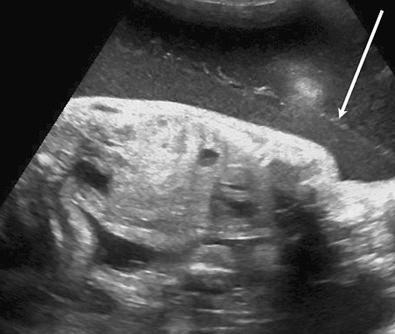
Postoperative management generally involves 24 hours of intravenous tocolysis with magnesium sulfate as well as maintenance with oral indomethacin for a total of 48 hours. Antibiotic “prophylaxis” is continued for 24 hours. Typically, ultrasound monitoring to evaluate the fetus, amniotic fluid volume, cervical length, and ductal patency is performed daily. Hospital discharge generally occurs 4 to 5 days after surgery. If the patient is stable without complications, long-term monitoring with follow-up sonograms usually involves weekly evaluation.
Minimally invasive fetal surgery generally refers to all invasive fetal interventions performed without the need for hysterotomy. Depending on the indications and goals of the procedure, minimally invasive fetal therapy may be performed under ultrasound guidance alone, such as needle or shunt placement procedures, or may require a combined approach with both sonography and endoscopy, also known as operative fetoscopy ( Table 24-1 ).
| Condition | Procedure |
|---|---|
| Needle and Shunts | |
| Alloimmunization | Transfusion |
| Bronchopulmonary sequestration | Interstitial ablation of feeding vessel |
| Congenital pulmonary airway malformation | Thoracoamniotic shunt or sclerotherapy |
| Critical aortic stenosis | Balloon valvuloplasty |
| Iatrogenic preterm premature rupture of fetal membranes | Amniopatch |
| Lower urinary tract obstruction | Vesicoamniotic shunt |
| Pleural effusion | Thoracoamniotic shunt |
| Pericardial teratoma with effusion | Pericardioamniotic shunt |
| Symptomatic polyhydramnios | Amnioreduction |
| Operative Fetoscopy | |
| Amniotic band syndrome | Lysis of constriction bands |
| Chorioangioma | Ablation of feeding vessels |
| Congenital diaphragmatic hernia | Tracheal occlusion |
| Myelomeningocele | Fetoscopic patch or closure |
| Twin reversed arterial perfusion sequence | Umbilical cord occlusion |
| Twin-twin transfusion syndrome | Laser photocoagulation of communicating vessels |
| Vasa previa (type II) | Laser occlusion of vasa previa |
| Sacrococcygeal teratoma | Interruption of vascular supply |
Ultrasound-guided needle interventions include intrauterine transfusion (IUT) and amnioreduction. Shunts are used when indicated for chronic drainage of abnormal, fluid-filled fetal cavities, organs, and cysts. A wide variety of fetal conditions have been surgically managed via operative fetoscopy. This technique, which utilizes a 3.3-mm or smaller endoscope, is associated with significantly lower risk of preterm birth, neonatal morbidity, and maternal morbidity as compared to open fetal surgery. There is a lower rate of preterm labor and of PPROM. The length of hospitalization and time until return to normal maternal activity are also shorter. In addition, patients who have undergone minimally invasive fetal therapy do not require cesarean delivery for the index pregnancy or for future pregnancies.
Minimally invasive procedures are performed under local or regional anesthesia. Depending on the gestational age and the protocols of the medical center, the procedure may be performed in the surgical operating room, labor and delivery unit, or ultrasound examination suite. Operative fetoscopy requires simultaneous utilization of ultrasound and fetoscopic imaging. Access to the amniotic cavity is achieved with thin-walled semiflexible plastic cannulas and either a plastic blunt-ended obturator using the Seldinger technique or sharp trocars. Specifics have been reviewed in several texts. Ultrasound imaging is used to identify an appropriate entry point and then to direct the instrument into the amniotic cavity, avoiding the placenta and the fetus and maternal organs such as bowel and bladder. The obturator/trocar is replaced by the fetoscope. Sonography is still used to direct the scope within the uterus, because its field and depth of view can be relatively limited. At the conclusion of the procedure, the sheath is removed. As the puncture is only 1 to 3 mm in size, the uterine wall spontaneously closes with minimal risk of amniotic fluid leak from the insertion site. In many cases, little or no tocolytic medication is needed, and patients are generally discharged from the hospital within 24 hours following the procedure.
The ex utero intrapartum therapy (EXIT) procedure is a specialized surgical procedure performed at the time of delivery. It was first developed in the early 1990s to permit the controlled reversal of tracheal occlusion performed in utero for the treatment of severe CDH ( Fig. 24-3 ). This procedure is utilized in cases in which prenatal ultrasound findings predict significant neonatal airway compromise, resulting from lesions such as large oral or neck masses, or congenital high airway obstruction syndrome (CHAOS). Maternal general endotracheal anesthesia with high levels of an inhalational agent is provided to maintain uterine quiescence. The fetal head and neck are delivered through a low transverse uterine incision, protecting the umbilical cord and maintaining uteroplacental blood flow for an extended period of time. This allows for the performance of a surgical procedure or lifesaving intervention while the fetus continues to be oxygenated and ventilated through placental support. The EXIT procedure has been used to perform fetal bronchoscopy, laryngoscopy, tracheostomy, cannulation for extracorporeal membrane oxygenation (ECMO), and even resection of a lung mass or lobectomy.
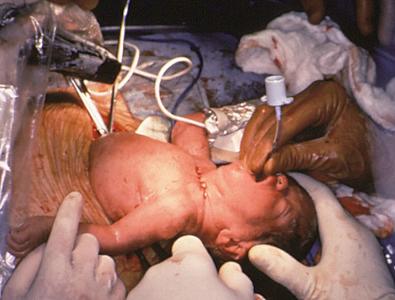
Once the uterus is exposed, intraoperative ultrasound assessment is required to confirm placental location and fetal position. The hysterotomy is performed, avoiding placental margins along the lower uterine segment. Preventing complete decompression of the uterus is important to reduce the likelihood of placental separation. This can be achieved by keeping the lower part of the fetal body within the uterus and by performing continuous amnioinfusion with a catheter. The EXIT procedure is not a simple variation of a cesarean delivery and should be carried out in specialized centers. The presence of a complete multidisciplinary team is required to perform appropriate preoperative evaluation, including discussion of the fetal diagnosis, counseling, and planning for the EXIT procedure. The intraoperative team includes an anesthesiologist, maternal-fetal medicine specialist, pediatric surgical subspecialist(s), and operating room nursing assistants. Neonatologists and a second complete operative team should be prepared to receive the newborn in the event that corrective measures performed while still on umbilical circulation are unsuccessful.
Monochorionic twin gestations are associated with a high risk of significant perinatal morbidity and mortality as compared to dichorionic twins and singletons. This increased risk is partially attributed to the unique placental vascular communications present in monochorionic twin gestations. Because the circulatory systems communicate, the death of one monochorionic twin may result in acute hypotension in the survivor; this hemodynamic instability may result in subsequent death or injury to the co-twin. A systematic review of 28 primary studies, including over 4500 twin pregnancies with in utero demise of one twin, reported that the rate of monochorionic versus dichorionic co-twin demise was 12% versus 4%, and the rate of neurologic abnormality in the surviving co-twin was 18% versus 1%, respectively. Placental vascular communications are also thought to be important factors in the development of twin-twin transfusion syndrome (TTTS), twin anemia-polycythemia sequence (TAPS), and twin reversed arterial perfusion (TRAP) sequence.
Placental share is an additional factor with significant impact on perinatal outcomes in monochorionic twins. Marked unequal partitioning of the placental mass may be manifest clinically by selective fetal growth restriction (sFGR). Finally, the risk of structural anomalies is increased in monochorionic twins, including in particular those involving the central nervous system as well as cardiac and gastrointestinal tract abnormalities. Over 80% of such anomalies are discordant (only one twin affected). Some of these anomalies are associated with a high risk of fetal demise if managed expectantly. Even without the previously described complications, monochorionic twins are at an increased risk of neurodevelopment impairment. In one study, Ortibus and colleagues prospectively followed 136 monochorionic twin pregnancies from the first trimester through infancy. After excluding pregnancies complicated by TTTS, discordant growth, intrauterine fetal demise (IUFD), and prematurity (birth before 32 weeks' gestation), the authors found that the 160 remaining infants had a 7% risk of neurodevelopmental impairment and a 0.6% risk of cerebral palsy.
Complications affect approximately 20% of monochorionic twins, and, thus, accurate diagnosis and close surveillance of these pregnancies are recommended. Chorionicity should be established as early as possible in the pregnancy. First and early second trimester ultrasound examination has been shown to be highly accurate in determining chorionicity and should be performed to allow for appropriate triage and management of the pregnancy. Close surveillance of monochorionic twins should include frequent sonograms, typically performed every 2 weeks, to monitor amniotic fluid volumes and fetal bladders. Cervical length assessment and Doppler interrogation should be performed, if necessary. If TTTS, TAPS, TRAP, sFGR, or discordant structural anomalies are suspected, the patient should be referred to an experienced center.
TTTS occurs in approximately 10% of monochorionic twins. Most experts believe that TTTS develops in monochorionic twin pairs as a result of unbalanced net flow of blood through vascular communications in the shared placenta. A series of pathophysiologic changes ensue from the net shunting of blood from one twin (donor) to the other twin (recipient), resulting in hypovolemia and oliguria in one, and volume overload and polyuria in the other ( Fig. 24-4A ). These hemodynamic derangements result in a cascade of physiologic changes leading to donor twin oligohydramnios, recipient twin polyhydramnios, and characteristic anatomic and arteriovenous flow alterations that can be identified by sonography with Doppler. Without intervention, early severe TTTS has a very high rate of perinatal injury or death.
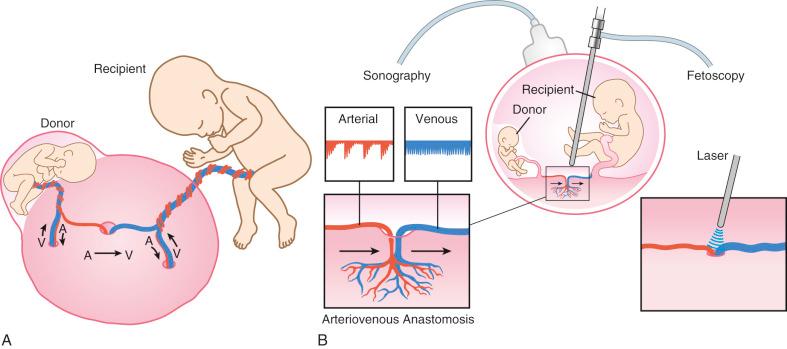
The diagnosis of TTTS is based on the following in utero ultrasound-based criteria: (1) monochorionicity and (2) single maximal vertical pocket (MVP) of amniotic fluid less than 2.0 cm on one side of the dividing membrane, and MVP of more than 8.0 cm on the other side. Once the diagnosis has been established, the syndrome may be staged according to the Quintero staging system ( Table 24-2 ). The establishment of diagnostic criteria and the classification of TTTS by Quintero and associates. have allowed researchers to compare outcome data following various therapeutic interventions and to predict perinatal survival after treatment.
| Stage | Polyhydramnios/Oligohydramnios * | Persistently Empty Bladder in Donor | Abnormal Doppler † | Hydrops | Demise |
|---|---|---|---|---|---|
| I | X | ||||
| II | X | X | |||
| III | X | X | X | ||
| IV | X | ||||
| V | X |
* Polyhydramnios is defined as deepest vertical pocket 8 cm or greater; oligohydramnios is defined as deepest vertical pocket 2 cm or less.
† At least one of the following: (1) umbilical artery absent/reserved end-diastolic flow, (2) absent/reversed end-diastolic flow in the ductus venosus, (3) pulsatile umbilical venous flow.
The perinatal mortality rate of expectantly managed TTTS has been reported to be as high as 95%. Of the various treatment approaches that have been considered for TTTS, those with the best-reported outcomes are serial amniocenteses and selective laser photocoagulation of communicating vessels (SLPCV) via operative fetoscopy ( Fig. 24-4B ). Serial amniocentesis (or amnioreduction) involves drainage of amniotic fluid from the polyhydramniotic recipient sac using vacuum-assisted devices attached to an 18- to 20-gauge spinal needle. The volume of amniotic fluid that should be withdrawn has not been standardized, although usually the MVP of amniotic fluid in the recipient sac is reduced to approximately 8 cm or less. Serial amniocenteses serve to significantly reduce the amount of amniotic fluid in the recipient sac, thereby diminishing overall uterine distention.
SLPCV is performed via operative fetoscopy, allowing direct visualization of the vessels on the placental surface. Once mapping of vascular communications has been performed, those vessels are occluded using laser energy ( Figs. 24-5 and 24-6 ). The basic principle of SLPCV is that the causative inter-twin vascular communications are ablated, thus treating the underlying pathogenic cause of this syndrome. With laser surgery, the circulations in a shared placenta are divided, functionally converting it to a dichorionic twin pregnancy, with improved perinatal outcomes.
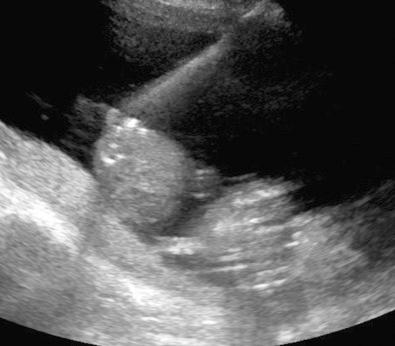
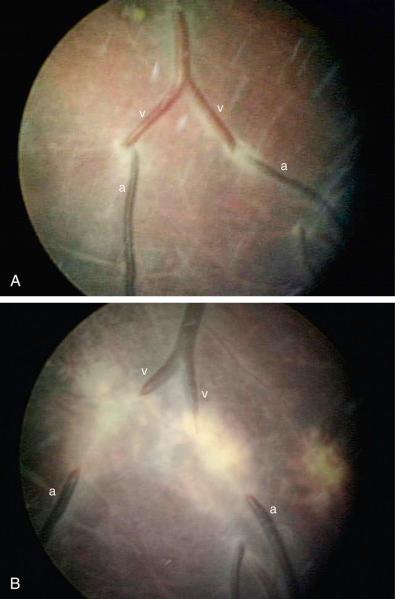
After the introduction of laser ablation as a treatment option for TTTS, the Eurofetus group conducted a randomized controlled trial that compared serial amniocentesis to SLPCV. Pretrial power analysis projected the need for a total of 172 patients to demonstrate a significant difference in outcomes between the two treatment arms. However, after enrollment of 142 patients, interim analysis revealed that the perinatal survival rate of at least one twin was 51% (36/70) in the amnioreduction arm versus 76% (55/72) in the laser therapy arm. Based on this statistically significant difference, the study was halted. In addition, in the laser group, pregnancy duration was approximately 4 weeks longer (33 weeks vs. 29 weeks, P = 0.003). The amnioreduction group had a significantly higher rate of neurologic complications (14% vs. 6%, P = 0.02), and this difference persisted at the 6-month follow-up evaluation.
Most subsequent studies have confirmed that SLPCV is the optimal treatment for TTTS. Intervention with laser surgery has resulted in survival rates for at least one twin ranging from 65% to 93% and dual survival rates ranging from 18% to 62%. Although several factors may influence perinatal outcomes in laser-treated TTTS patients, one important consideration is disease severity. Knowledge of perinatal outcomes of TTTS pregnancies treated with laser, stratified by Quintero stage, may facilitate patient selection and counseling. In a series of 682 consecutive cases of TTTS treated via SLPCV, there was a 91% perinatal survival rate of at least one twin and 67% survival rate of both twins. Of note, perinatal survival of at least one fetus has been reported to be independent of Quintero stage, whereas dual twin survival does appear to differ based on stage. This is predominantly because stage III pregnancies are associated with decreased donor twin survival ( Table 24-3 ), particularly in those with growth restriction of the donor. These pregnancies are nearly twice as likely as those without growth restriction to suffer in utero demise of the donor. The average gestational age at delivery following laser surgery is approximately 33 weeks, with 10% delivering between 24 and 28 weeks' gestation. The laser surgical technique has undergone recent modifications that may further improve perinatal outcomes.
| Stage I ( n = 114) |
Stage II ( n = 177) |
Stage III ( n = 328) |
Stage IV ( n = 63) |
|
|---|---|---|---|---|
| At least 1 survivor | 92% | 93% | 88% | 92% |
| Dual survival | 79% | 76% | 59% * | 68% |
* Decreased dual twin survival in Quintero stage III patients predominantly from decreased donor twin survival in cases complicated by severe growth restriction.
The surgical goal of SLPCV is to completely occlude all placental vascular connections between the twin pair. A missed or inadequately lasered vessel, referred to as a residual anastomosis (RA), may be associated with adverse perinatal outcomes such as persistent or reversed TTTS or TAPS. Pathologic confirmation of complete ablation of vascular communications can be ascertained via ex vivo placental injection studies in cases without placental maceration related to IUFD. RA after SLPCV has been reported to be as low as 4% to 5%, although some studies have reported frequencies of RA ranging from 32% to as high as 75% of cases. In a 2014 trial investigating laser coagulation of the entire vascular equator, the rate of RA was still 19%. The wide range of RA rates in these studies has been attributed to the laser technique employed and to the method of placental evaluation.
Despite evidence that SLPCV improves neonatal survival and reduces morbidity, cerebral injury is not fully prevented. Periventricular infarction, hemorrhagic injury, and ischemic white matter damage have been detected prenatally in fetuses treated with laser surgery for TTTS. The incidence of cerebral damage may be underestimated, because neurodevelopmental impairment and intellectual disability may only manifest several months or years after birth. Thus, a major concern for clinicians and parents is the rate of neurologic impairment in survivors. A systematic review found that the risk of neurodevelopmental impairment after laser therapy for TTTS is about 11%. Cerebral palsy was the most frequent diagnosis, accounting for about 40% of abnormal neurologic outcomes. In a cohort of 100 TTTS survivors treated with in utero laser surgery, formal neurodevelopmental testing, performed at 2 years of age, revealed normal range mean Battelle Developmental Inventory, 2nd edition (BDI-2) scores of 101.3 (standard deviation [SD] = 12.2) for the entire cohort. The overall rate of neurodevelopmental impairment, defined as blindness, deafness, cerebral palsy, or BDI-2 score less than 70, was 4%.
Become a Clinical Tree membership for Full access and enjoy Unlimited articles
If you are a member. Log in here